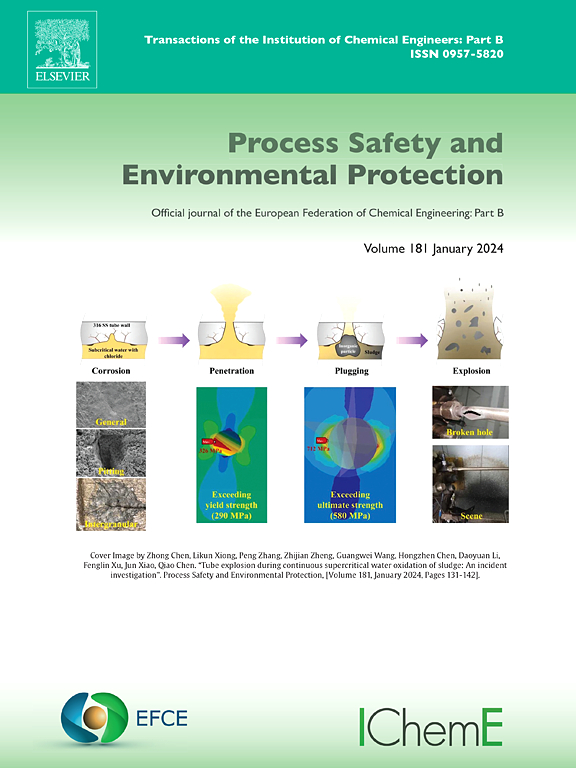Impact of support mesh material on cake layer formation and fouling in an anoxic dynamic membrane bioreactor
IF 6.9
2区 环境科学与生态学
Q1 ENGINEERING, CHEMICAL
引用次数: 0
Abstract
This study investigated the role of different support mesh materials (brass, stainless steel, and nylon) on cake layer formation and membrane fouling in Anoxic Dynamic Membrane Bioreactor (AnDMBR). Our results showed that stainless steel mesh exhibited the most stable operation, with minimal deformation and lower fouling rates, while brass and nylon meshes were more flexible and prone to folding. The malleability of brass mesh might result in more oscillations in mesh opening sizes, and its antimicrobial surface properties promoted rapid organic matter accumulation without efficient biodegradation, leading to a sharp rise in transmembrane pressure (TMP). The observation was supported by the fact that the brass-supported cake layer exhibited the highest surface roughness compared with other cake layer samples. The brass-supported cake layer also showed the highest surface roughness, which enhanced lateral microbial attachment and improved the structural stability and filtration performance of dynamic membrane. Proteobacteria and Bacteroidetes were the dominant phyla across all cake layers, with genus Thiobacillus playing a key role among other predominant genera. Overall, our results highlight the critical role of support mesh material in optimizing cake layer formation and stability in AnDMBRs, with stainless steel emerging as the most optimal material for operation.
支撑网材料对厌氧动态膜生物反应器中滤饼层形成和污染的影响
研究了不同支撑网材料(黄铜、不锈钢和尼龙)对厌氧动态膜生物反应器(AnDMBR)滤饼层形成和膜污染的影响。我们的研究结果表明,不锈钢网表现出最稳定的运行,最小的变形和较低的污垢率,而黄铜和尼龙网更灵活,容易折叠。黄铜网的延展性可能导致网孔尺寸的振荡较大,其抗菌表面特性促进了有机物的快速积累而没有有效的生物降解,导致跨膜压力(TMP)急剧上升。黄铜支撑的饼层与其他饼层样品相比具有最高的表面粗糙度,这一事实支持了这一观察结果。黄铜支撑的饼层表面粗糙度最高,增强了微生物的侧向附着,提高了动态膜的结构稳定性和过滤性能。变形菌门和拟杆菌门是各菌层的优势门,硫杆菌属在其他优势属中起关键作用。总的来说,我们的研究结果强调了支撑网材料在优化andmbr中饼层形成和稳定性方面的关键作用,其中不锈钢成为最理想的运行材料。
本文章由计算机程序翻译,如有差异,请以英文原文为准。
求助全文
约1分钟内获得全文
求助全文
来源期刊

Process Safety and Environmental Protection
环境科学-工程:化工
CiteScore
11.40
自引率
15.40%
发文量
929
审稿时长
8.0 months
期刊介绍:
The Process Safety and Environmental Protection (PSEP) journal is a leading international publication that focuses on the publication of high-quality, original research papers in the field of engineering, specifically those related to the safety of industrial processes and environmental protection. The journal encourages submissions that present new developments in safety and environmental aspects, particularly those that show how research findings can be applied in process engineering design and practice.
PSEP is particularly interested in research that brings fresh perspectives to established engineering principles, identifies unsolved problems, or suggests directions for future research. The journal also values contributions that push the boundaries of traditional engineering and welcomes multidisciplinary papers.
PSEP's articles are abstracted and indexed by a range of databases and services, which helps to ensure that the journal's research is accessible and recognized in the academic and professional communities. These databases include ANTE, Chemical Abstracts, Chemical Hazards in Industry, Current Contents, Elsevier Engineering Information database, Pascal Francis, Web of Science, Scopus, Engineering Information Database EnCompass LIT (Elsevier), and INSPEC. This wide coverage facilitates the dissemination of the journal's content to a global audience interested in process safety and environmental engineering.
 求助内容:
求助内容: 应助结果提醒方式:
应助结果提醒方式:


